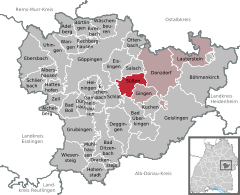Süßen
| Süßen | ||
|---|---|---|
| ||
 Süßen | ||
Location of Süßen within Göppingen district 
 | ||
| Coordinates: 48°40′47″N 9°45′27″E / 48.67972°N 9.75750°ECoordinates: 48°40′47″N 9°45′27″E / 48.67972°N 9.75750°E | ||
| Country | Germany | |
| State | Baden-Württemberg | |
| Admin. region | Stuttgart | |
| District | Göppingen | |
| Government | ||
| • Mayor | Marc O. Kersting | |
| Area | ||
| • Total | 12.78 km2 (4.93 sq mi) | |
| Population (2013-12-31)[1] | ||
| • Total | 9,798 | |
| • Density | 770/km2 (2,000/sq mi) | |
| Time zone | CET/CEST (UTC+1/+2) | |
| Postal codes | 73079 | |
| Dialling codes | 07162 | |
| Vehicle registration | GP | |
| Website | www.suessen.de | |
Süßen (or Süssen) is a town in the district of Göppingen in Baden-Württemberg in southern Germany. It is located on the river Fils 8 km east of Göppingen, near Stuttgart.
History
Süßen was first mentioned with the name of Siezun in the Lorsch codex in 1071. Großsüßen (Greater Süßen) was at first in the possession of the count of Helfenstein, who, in 1382 pledged it to the city of Ulm. Kleinsüßen (Smaller Süßen), on the other hand, was in the hands of the family Pappenheim. They inherited the land forward to the landlords of Bubenhofen.
In frames of the Mediatization in 1802, Großsüßen was given to Bavaria but in 1810 the lands were given back, in frames of an exchange contract to Württemberg. Kleinsüßen was on the other hand never Bavarian land. After the exchange, both places, Groß- and Kleinsüßen were assigned under the Head Office of Geislingen.
With the opening of the Fils Valley Railway and Süßen station in 1847, Kleinsüßen was connected to the public transportation.
In 1933, the two townships, Großsüßen and Kleinsüßen were unified and the settlement Süßen was formed. The war reform in 1938 assigned the town to the region of Göppingen.
On July 1, 1996, Süßen obtained the title of town.
Religions
In 1539 Protestantism was officially introduced in Großsüßen, being part of Ulm. Kleinsüßen, owned by the Pappenheims, remained Roman Catholic.
Population
The development of the population
| Date | Population |
|---|---|
| 1837 | 1,440 |
| 1907 | 2,425 |
| 1939 | 3,925 |
| 1950 | 5.946 |
| 1970 | 8.258 |
| 1983 | 8.433 |
| 2007 | 10.254 |
Coat of arms and flag
The official coat of arms contains a black-white part and three red zig-zag lines. This shield became the official coat of arms in 1933. The red zig-zag lines represent the landlords of Bubenhofen, the former land owners. The black-white part represents the connections to Ulm. The red-white flag of the town was given on 13. March 1958 by the Ministry of Internal Affairs.
Partnerships
Süßen is a partner town of the Hungarian Törökbálint. This connection was established, when on 26. February 1946 the first Hungarian-Germans (266 of them) arrived from Törökbálint to Süßen, chased away by the Hungarian communists and the arriving Soviets.
Politics
According to the results of the communal elections on 13. June 2004, the proportions of the political power in the Municipal Office are as follows (showing the changes to the previous elections):
- The Conservatives: CDU 32,6% (−2,4) – 6 seats (=)
- The Democrats: FDP/AFW 27,4% (+3,5) – 5 seats (+1)
- The Socialists: SPD 23,8% (−6,8) – 4 seats (−2)
- The Liberals/Greens: GRÜNE 16,1% (+5,3) – 3 seats (+1)
Events
- Easter Market
- Schützenfest on the weekend following June 2
- Town Festival, Stadtfest on the weekend following July 2
- Christmas market on Saturday before the second advent
Buildings
- A historic well in the town centre. Not really an "old" well, but it represents the history of Süßen. The well itself was built in 1981, planned by Emil Jo Homolka.
- The Gothic Ulrich Church
- The old Gothic Maria Church
- The new Maria Church in Expressionistic style, built in 1929
- The memorial of the poet Johann Georg Fischer on the Heidenheimer street
References
External links
|
